Impact of Staff Motivation on Hotel Industry: A Case Study
VerifiedAdded on 2020/01/21
|50
|12586
|451
Report
AI Summary
This report presents a case study on the impact of staff motivation within the hotel industry, focusing on the Barking Travelodge. The study investigates the significance of employee motivation, particularly in a customer-centric sector, and its influence on employee behavior. It explores various motivational factors, including promotion, recognition, and job security, and their effects on staff performance and contribution to hotel objectives. The research employs both qualitative and quantitative methods, including interviews, to analyze these factors and identify gender-based motivational differences. The report highlights the importance of employee engagement, effective leadership, and open communication in fostering a positive work environment and enhancing employee behavior. The study also addresses the challenges of high attrition rates and the importance of retaining quality personnel through motivational strategies. The findings provide insights into how hotel management can improve employee satisfaction and overall organizational success.

Impact of staff motivation on hotel industry and the
way it changes their behavior. A case study of
Barking Travelodge
way it changes their behavior. A case study of
Barking Travelodge
Paraphrase This Document
Need a fresh take? Get an instant paraphrase of this document with our AI Paraphraser
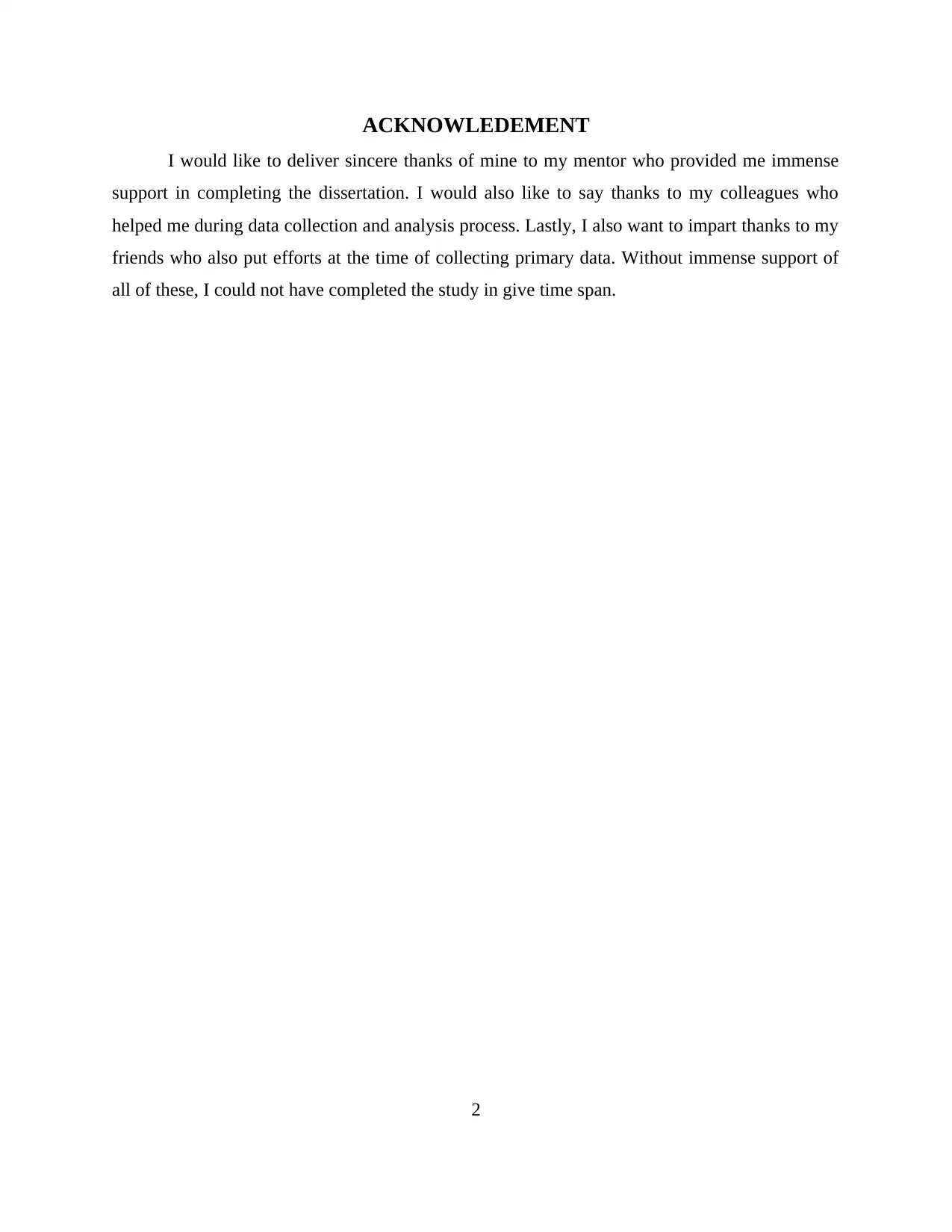
ACKNOWLEDEMENT
I would like to deliver sincere thanks of mine to my mentor who provided me immense
support in completing the dissertation. I would also like to say thanks to my colleagues who
helped me during data collection and analysis process. Lastly, I also want to impart thanks to my
friends who also put efforts at the time of collecting primary data. Without immense support of
all of these, I could not have completed the study in give time span.
2
I would like to deliver sincere thanks of mine to my mentor who provided me immense
support in completing the dissertation. I would also like to say thanks to my colleagues who
helped me during data collection and analysis process. Lastly, I also want to impart thanks to my
friends who also put efforts at the time of collecting primary data. Without immense support of
all of these, I could not have completed the study in give time span.
2
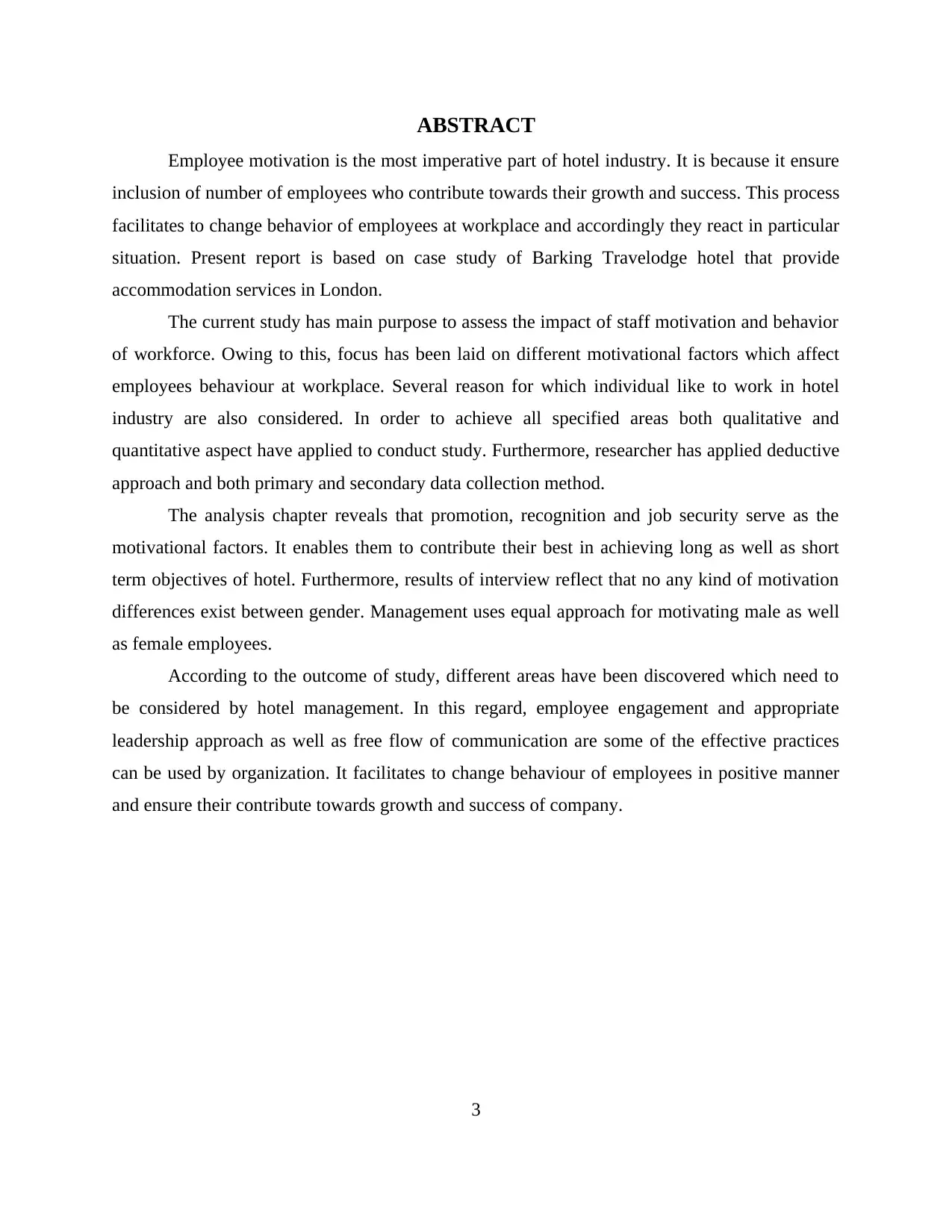
ABSTRACT
Employee motivation is the most imperative part of hotel industry. It is because it ensure
inclusion of number of employees who contribute towards their growth and success. This process
facilitates to change behavior of employees at workplace and accordingly they react in particular
situation. Present report is based on case study of Barking Travelodge hotel that provide
accommodation services in London.
The current study has main purpose to assess the impact of staff motivation and behavior
of workforce. Owing to this, focus has been laid on different motivational factors which affect
employees behaviour at workplace. Several reason for which individual like to work in hotel
industry are also considered. In order to achieve all specified areas both qualitative and
quantitative aspect have applied to conduct study. Furthermore, researcher has applied deductive
approach and both primary and secondary data collection method.
The analysis chapter reveals that promotion, recognition and job security serve as the
motivational factors. It enables them to contribute their best in achieving long as well as short
term objectives of hotel. Furthermore, results of interview reflect that no any kind of motivation
differences exist between gender. Management uses equal approach for motivating male as well
as female employees.
According to the outcome of study, different areas have been discovered which need to
be considered by hotel management. In this regard, employee engagement and appropriate
leadership approach as well as free flow of communication are some of the effective practices
can be used by organization. It facilitates to change behaviour of employees in positive manner
and ensure their contribute towards growth and success of company.
3
Employee motivation is the most imperative part of hotel industry. It is because it ensure
inclusion of number of employees who contribute towards their growth and success. This process
facilitates to change behavior of employees at workplace and accordingly they react in particular
situation. Present report is based on case study of Barking Travelodge hotel that provide
accommodation services in London.
The current study has main purpose to assess the impact of staff motivation and behavior
of workforce. Owing to this, focus has been laid on different motivational factors which affect
employees behaviour at workplace. Several reason for which individual like to work in hotel
industry are also considered. In order to achieve all specified areas both qualitative and
quantitative aspect have applied to conduct study. Furthermore, researcher has applied deductive
approach and both primary and secondary data collection method.
The analysis chapter reveals that promotion, recognition and job security serve as the
motivational factors. It enables them to contribute their best in achieving long as well as short
term objectives of hotel. Furthermore, results of interview reflect that no any kind of motivation
differences exist between gender. Management uses equal approach for motivating male as well
as female employees.
According to the outcome of study, different areas have been discovered which need to
be considered by hotel management. In this regard, employee engagement and appropriate
leadership approach as well as free flow of communication are some of the effective practices
can be used by organization. It facilitates to change behaviour of employees in positive manner
and ensure their contribute towards growth and success of company.
3
⊘ This is a preview!⊘
Do you want full access?
Subscribe today to unlock all pages.

Trusted by 1+ million students worldwide
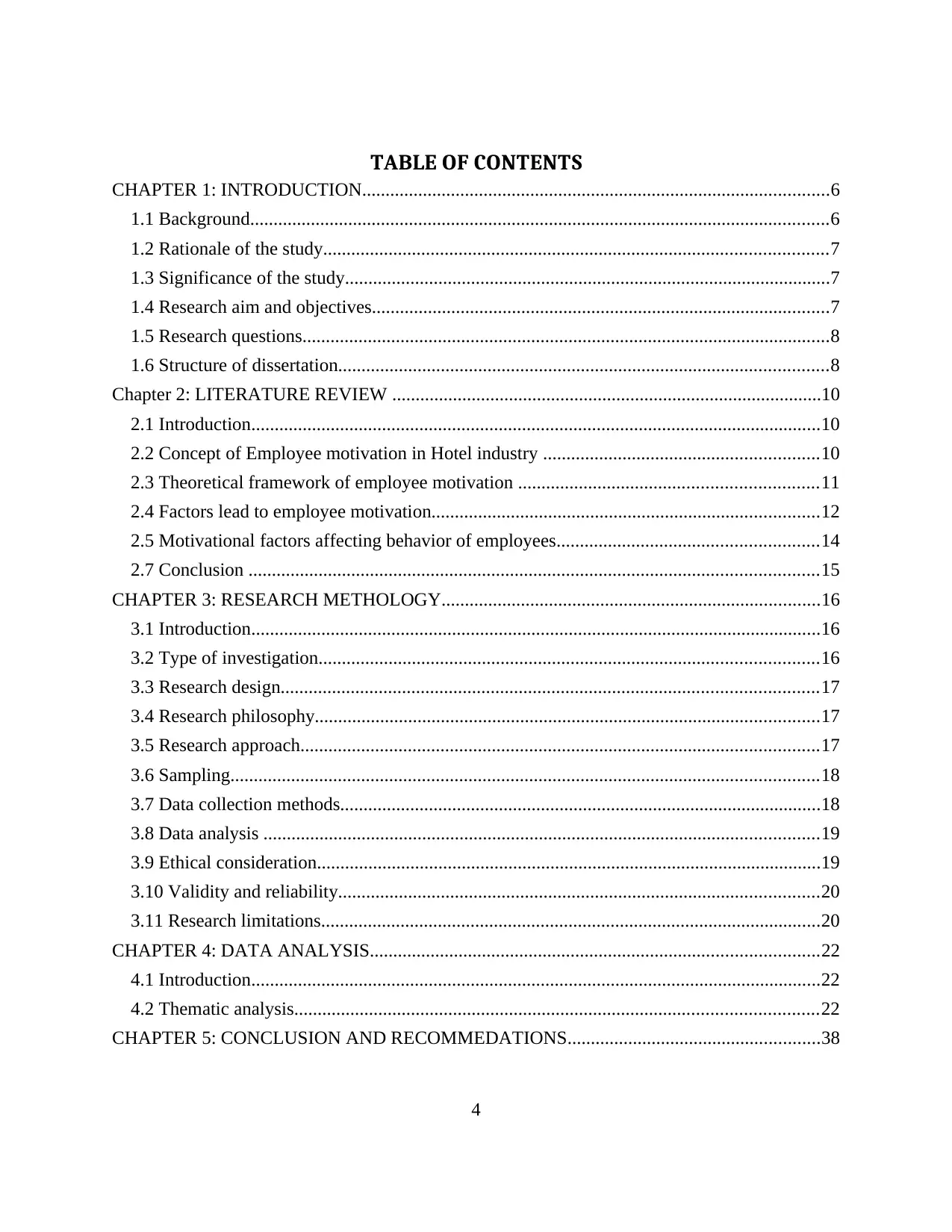
TABLE OF CONTENTS
CHAPTER 1: INTRODUCTION....................................................................................................6
1.1 Background............................................................................................................................6
1.2 Rationale of the study............................................................................................................7
1.3 Significance of the study........................................................................................................7
1.4 Research aim and objectives..................................................................................................7
1.5 Research questions.................................................................................................................8
1.6 Structure of dissertation.........................................................................................................8
Chapter 2: LITERATURE REVIEW ............................................................................................10
2.1 Introduction..........................................................................................................................10
2.2 Concept of Employee motivation in Hotel industry ...........................................................10
2.3 Theoretical framework of employee motivation ................................................................11
2.4 Factors lead to employee motivation...................................................................................12
2.5 Motivational factors affecting behavior of employees........................................................14
2.7 Conclusion ..........................................................................................................................15
CHAPTER 3: RESEARCH METHOLOGY.................................................................................16
3.1 Introduction..........................................................................................................................16
3.2 Type of investigation...........................................................................................................16
3.3 Research design...................................................................................................................17
3.4 Research philosophy............................................................................................................17
3.5 Research approach...............................................................................................................17
3.6 Sampling..............................................................................................................................18
3.7 Data collection methods.......................................................................................................18
3.8 Data analysis .......................................................................................................................19
3.9 Ethical consideration............................................................................................................19
3.10 Validity and reliability.......................................................................................................20
3.11 Research limitations...........................................................................................................20
CHAPTER 4: DATA ANALYSIS................................................................................................22
4.1 Introduction..........................................................................................................................22
4.2 Thematic analysis................................................................................................................22
CHAPTER 5: CONCLUSION AND RECOMMEDATIONS......................................................38
4
CHAPTER 1: INTRODUCTION....................................................................................................6
1.1 Background............................................................................................................................6
1.2 Rationale of the study............................................................................................................7
1.3 Significance of the study........................................................................................................7
1.4 Research aim and objectives..................................................................................................7
1.5 Research questions.................................................................................................................8
1.6 Structure of dissertation.........................................................................................................8
Chapter 2: LITERATURE REVIEW ............................................................................................10
2.1 Introduction..........................................................................................................................10
2.2 Concept of Employee motivation in Hotel industry ...........................................................10
2.3 Theoretical framework of employee motivation ................................................................11
2.4 Factors lead to employee motivation...................................................................................12
2.5 Motivational factors affecting behavior of employees........................................................14
2.7 Conclusion ..........................................................................................................................15
CHAPTER 3: RESEARCH METHOLOGY.................................................................................16
3.1 Introduction..........................................................................................................................16
3.2 Type of investigation...........................................................................................................16
3.3 Research design...................................................................................................................17
3.4 Research philosophy............................................................................................................17
3.5 Research approach...............................................................................................................17
3.6 Sampling..............................................................................................................................18
3.7 Data collection methods.......................................................................................................18
3.8 Data analysis .......................................................................................................................19
3.9 Ethical consideration............................................................................................................19
3.10 Validity and reliability.......................................................................................................20
3.11 Research limitations...........................................................................................................20
CHAPTER 4: DATA ANALYSIS................................................................................................22
4.1 Introduction..........................................................................................................................22
4.2 Thematic analysis................................................................................................................22
CHAPTER 5: CONCLUSION AND RECOMMEDATIONS......................................................38
4
Paraphrase This Document
Need a fresh take? Get an instant paraphrase of this document with our AI Paraphraser
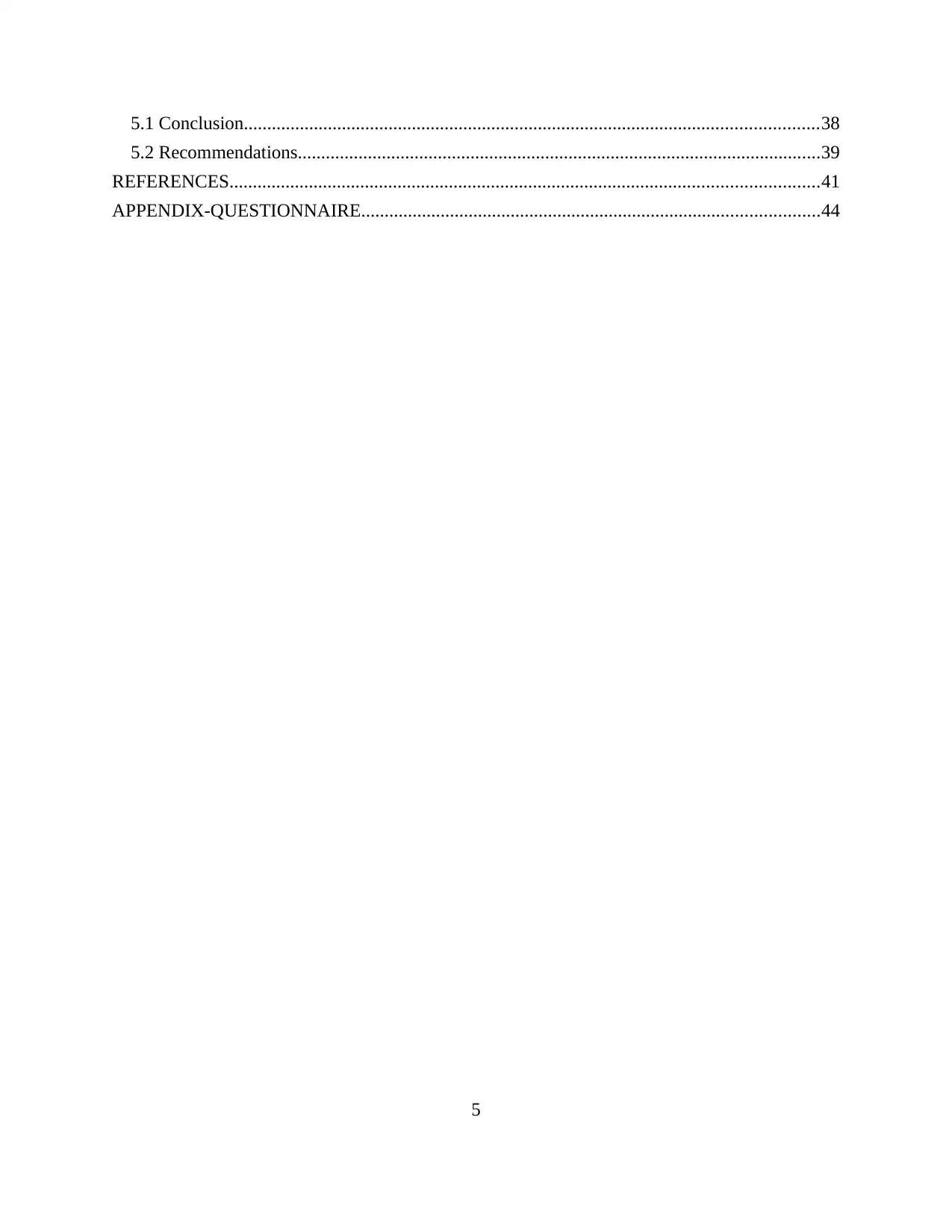
5.1 Conclusion...........................................................................................................................38
5.2 Recommendations................................................................................................................39
REFERENCES..............................................................................................................................41
APPENDIX-QUESTIONNAIRE..................................................................................................44
5
5.2 Recommendations................................................................................................................39
REFERENCES..............................................................................................................................41
APPENDIX-QUESTIONNAIRE..................................................................................................44
5
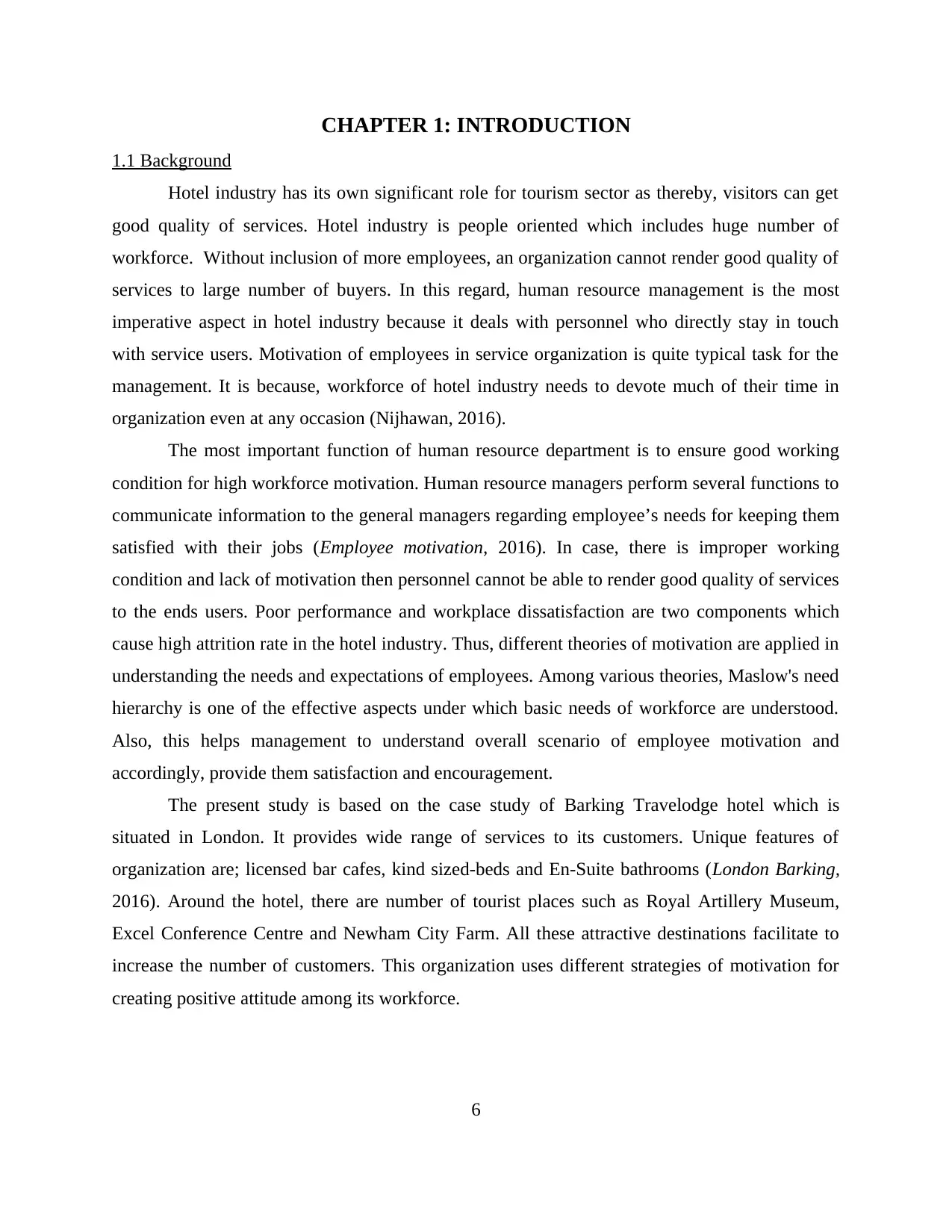
CHAPTER 1: INTRODUCTION
1.1 Background
Hotel industry has its own significant role for tourism sector as thereby, visitors can get
good quality of services. Hotel industry is people oriented which includes huge number of
workforce. Without inclusion of more employees, an organization cannot render good quality of
services to large number of buyers. In this regard, human resource management is the most
imperative aspect in hotel industry because it deals with personnel who directly stay in touch
with service users. Motivation of employees in service organization is quite typical task for the
management. It is because, workforce of hotel industry needs to devote much of their time in
organization even at any occasion (Nijhawan, 2016).
The most important function of human resource department is to ensure good working
condition for high workforce motivation. Human resource managers perform several functions to
communicate information to the general managers regarding employee’s needs for keeping them
satisfied with their jobs (Employee motivation, 2016). In case, there is improper working
condition and lack of motivation then personnel cannot be able to render good quality of services
to the ends users. Poor performance and workplace dissatisfaction are two components which
cause high attrition rate in the hotel industry. Thus, different theories of motivation are applied in
understanding the needs and expectations of employees. Among various theories, Maslow's need
hierarchy is one of the effective aspects under which basic needs of workforce are understood.
Also, this helps management to understand overall scenario of employee motivation and
accordingly, provide them satisfaction and encouragement.
The present study is based on the case study of Barking Travelodge hotel which is
situated in London. It provides wide range of services to its customers. Unique features of
organization are; licensed bar cafes, kind sized-beds and En-Suite bathrooms (London Barking,
2016). Around the hotel, there are number of tourist places such as Royal Artillery Museum,
Excel Conference Centre and Newham City Farm. All these attractive destinations facilitate to
increase the number of customers. This organization uses different strategies of motivation for
creating positive attitude among its workforce.
6
1.1 Background
Hotel industry has its own significant role for tourism sector as thereby, visitors can get
good quality of services. Hotel industry is people oriented which includes huge number of
workforce. Without inclusion of more employees, an organization cannot render good quality of
services to large number of buyers. In this regard, human resource management is the most
imperative aspect in hotel industry because it deals with personnel who directly stay in touch
with service users. Motivation of employees in service organization is quite typical task for the
management. It is because, workforce of hotel industry needs to devote much of their time in
organization even at any occasion (Nijhawan, 2016).
The most important function of human resource department is to ensure good working
condition for high workforce motivation. Human resource managers perform several functions to
communicate information to the general managers regarding employee’s needs for keeping them
satisfied with their jobs (Employee motivation, 2016). In case, there is improper working
condition and lack of motivation then personnel cannot be able to render good quality of services
to the ends users. Poor performance and workplace dissatisfaction are two components which
cause high attrition rate in the hotel industry. Thus, different theories of motivation are applied in
understanding the needs and expectations of employees. Among various theories, Maslow's need
hierarchy is one of the effective aspects under which basic needs of workforce are understood.
Also, this helps management to understand overall scenario of employee motivation and
accordingly, provide them satisfaction and encouragement.
The present study is based on the case study of Barking Travelodge hotel which is
situated in London. It provides wide range of services to its customers. Unique features of
organization are; licensed bar cafes, kind sized-beds and En-Suite bathrooms (London Barking,
2016). Around the hotel, there are number of tourist places such as Royal Artillery Museum,
Excel Conference Centre and Newham City Farm. All these attractive destinations facilitate to
increase the number of customers. This organization uses different strategies of motivation for
creating positive attitude among its workforce.
6
⊘ This is a preview!⊘
Do you want full access?
Subscribe today to unlock all pages.

Trusted by 1+ million students worldwide
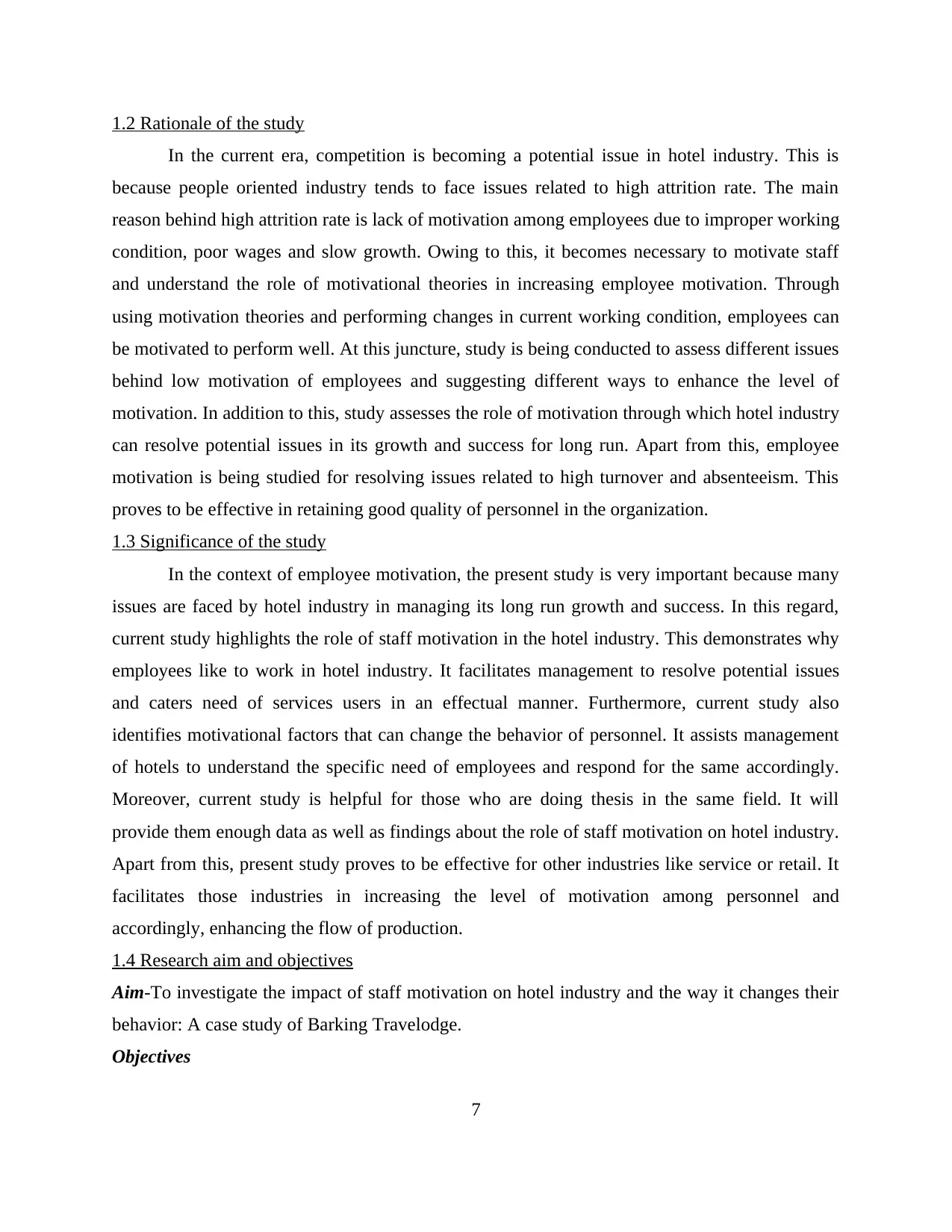
1.2 Rationale of the study
In the current era, competition is becoming a potential issue in hotel industry. This is
because people oriented industry tends to face issues related to high attrition rate. The main
reason behind high attrition rate is lack of motivation among employees due to improper working
condition, poor wages and slow growth. Owing to this, it becomes necessary to motivate staff
and understand the role of motivational theories in increasing employee motivation. Through
using motivation theories and performing changes in current working condition, employees can
be motivated to perform well. At this juncture, study is being conducted to assess different issues
behind low motivation of employees and suggesting different ways to enhance the level of
motivation. In addition to this, study assesses the role of motivation through which hotel industry
can resolve potential issues in its growth and success for long run. Apart from this, employee
motivation is being studied for resolving issues related to high turnover and absenteeism. This
proves to be effective in retaining good quality of personnel in the organization.
1.3 Significance of the study
In the context of employee motivation, the present study is very important because many
issues are faced by hotel industry in managing its long run growth and success. In this regard,
current study highlights the role of staff motivation in the hotel industry. This demonstrates why
employees like to work in hotel industry. It facilitates management to resolve potential issues
and caters need of services users in an effectual manner. Furthermore, current study also
identifies motivational factors that can change the behavior of personnel. It assists management
of hotels to understand the specific need of employees and respond for the same accordingly.
Moreover, current study is helpful for those who are doing thesis in the same field. It will
provide them enough data as well as findings about the role of staff motivation on hotel industry.
Apart from this, present study proves to be effective for other industries like service or retail. It
facilitates those industries in increasing the level of motivation among personnel and
accordingly, enhancing the flow of production.
1.4 Research aim and objectives
Aim-To investigate the impact of staff motivation on hotel industry and the way it changes their
behavior: A case study of Barking Travelodge.
Objectives
7
In the current era, competition is becoming a potential issue in hotel industry. This is
because people oriented industry tends to face issues related to high attrition rate. The main
reason behind high attrition rate is lack of motivation among employees due to improper working
condition, poor wages and slow growth. Owing to this, it becomes necessary to motivate staff
and understand the role of motivational theories in increasing employee motivation. Through
using motivation theories and performing changes in current working condition, employees can
be motivated to perform well. At this juncture, study is being conducted to assess different issues
behind low motivation of employees and suggesting different ways to enhance the level of
motivation. In addition to this, study assesses the role of motivation through which hotel industry
can resolve potential issues in its growth and success for long run. Apart from this, employee
motivation is being studied for resolving issues related to high turnover and absenteeism. This
proves to be effective in retaining good quality of personnel in the organization.
1.3 Significance of the study
In the context of employee motivation, the present study is very important because many
issues are faced by hotel industry in managing its long run growth and success. In this regard,
current study highlights the role of staff motivation in the hotel industry. This demonstrates why
employees like to work in hotel industry. It facilitates management to resolve potential issues
and caters need of services users in an effectual manner. Furthermore, current study also
identifies motivational factors that can change the behavior of personnel. It assists management
of hotels to understand the specific need of employees and respond for the same accordingly.
Moreover, current study is helpful for those who are doing thesis in the same field. It will
provide them enough data as well as findings about the role of staff motivation on hotel industry.
Apart from this, present study proves to be effective for other industries like service or retail. It
facilitates those industries in increasing the level of motivation among personnel and
accordingly, enhancing the flow of production.
1.4 Research aim and objectives
Aim-To investigate the impact of staff motivation on hotel industry and the way it changes their
behavior: A case study of Barking Travelodge.
Objectives
7
Paraphrase This Document
Need a fresh take? Get an instant paraphrase of this document with our AI Paraphraser
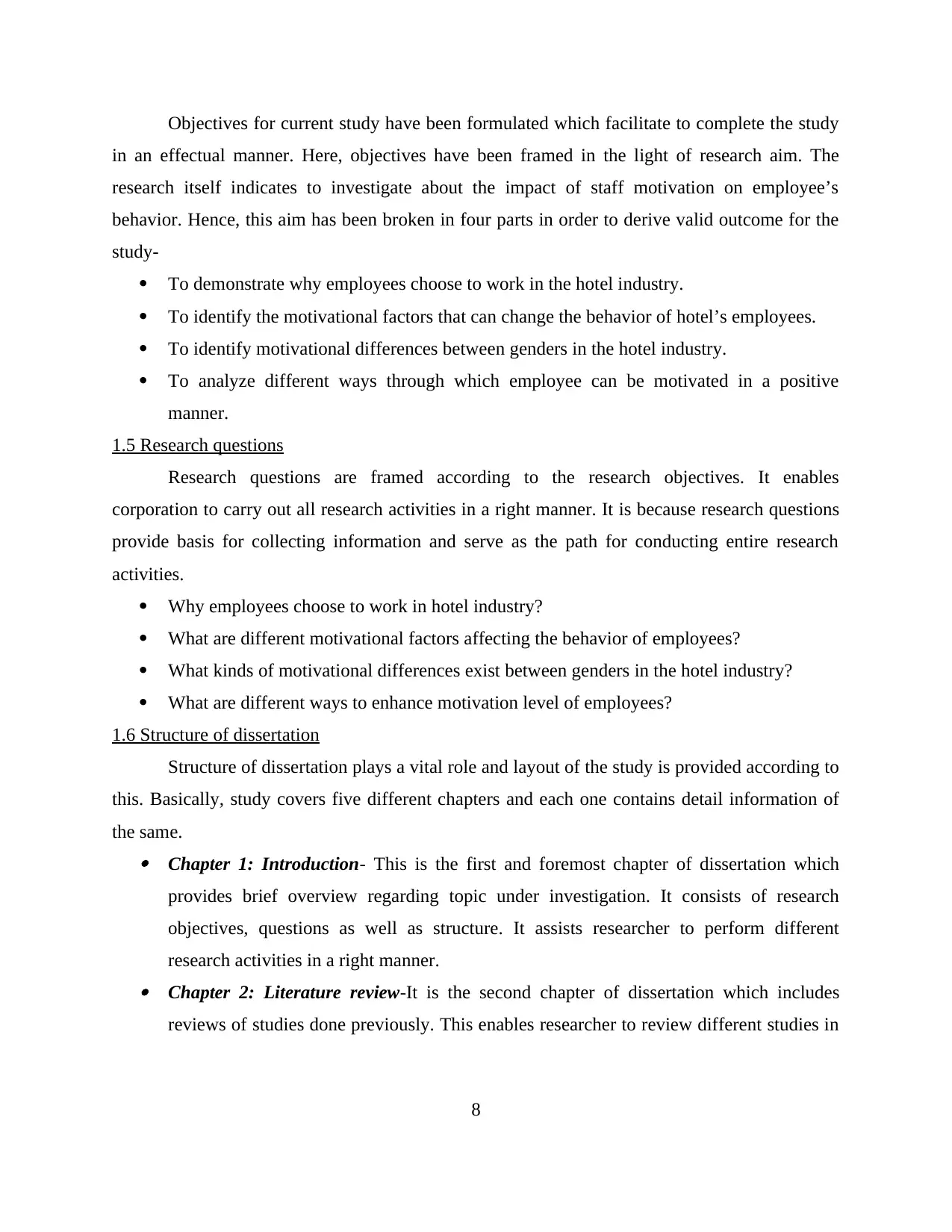
Objectives for current study have been formulated which facilitate to complete the study
in an effectual manner. Here, objectives have been framed in the light of research aim. The
research itself indicates to investigate about the impact of staff motivation on employee’s
behavior. Hence, this aim has been broken in four parts in order to derive valid outcome for the
study-
To demonstrate why employees choose to work in the hotel industry.
To identify the motivational factors that can change the behavior of hotel’s employees.
To identify motivational differences between genders in the hotel industry.
To analyze different ways through which employee can be motivated in a positive
manner.
1.5 Research questions
Research questions are framed according to the research objectives. It enables
corporation to carry out all research activities in a right manner. It is because research questions
provide basis for collecting information and serve as the path for conducting entire research
activities.
Why employees choose to work in hotel industry?
What are different motivational factors affecting the behavior of employees?
What kinds of motivational differences exist between genders in the hotel industry?
What are different ways to enhance motivation level of employees?
1.6 Structure of dissertation
Structure of dissertation plays a vital role and layout of the study is provided according to
this. Basically, study covers five different chapters and each one contains detail information of
the same. Chapter 1: Introduction- This is the first and foremost chapter of dissertation which
provides brief overview regarding topic under investigation. It consists of research
objectives, questions as well as structure. It assists researcher to perform different
research activities in a right manner. Chapter 2: Literature review-It is the second chapter of dissertation which includes
reviews of studies done previously. This enables researcher to review different studies in
8
in an effectual manner. Here, objectives have been framed in the light of research aim. The
research itself indicates to investigate about the impact of staff motivation on employee’s
behavior. Hence, this aim has been broken in four parts in order to derive valid outcome for the
study-
To demonstrate why employees choose to work in the hotel industry.
To identify the motivational factors that can change the behavior of hotel’s employees.
To identify motivational differences between genders in the hotel industry.
To analyze different ways through which employee can be motivated in a positive
manner.
1.5 Research questions
Research questions are framed according to the research objectives. It enables
corporation to carry out all research activities in a right manner. It is because research questions
provide basis for collecting information and serve as the path for conducting entire research
activities.
Why employees choose to work in hotel industry?
What are different motivational factors affecting the behavior of employees?
What kinds of motivational differences exist between genders in the hotel industry?
What are different ways to enhance motivation level of employees?
1.6 Structure of dissertation
Structure of dissertation plays a vital role and layout of the study is provided according to
this. Basically, study covers five different chapters and each one contains detail information of
the same. Chapter 1: Introduction- This is the first and foremost chapter of dissertation which
provides brief overview regarding topic under investigation. It consists of research
objectives, questions as well as structure. It assists researcher to perform different
research activities in a right manner. Chapter 2: Literature review-It is the second chapter of dissertation which includes
reviews of studies done previously. This enables researcher to review different studies in
8
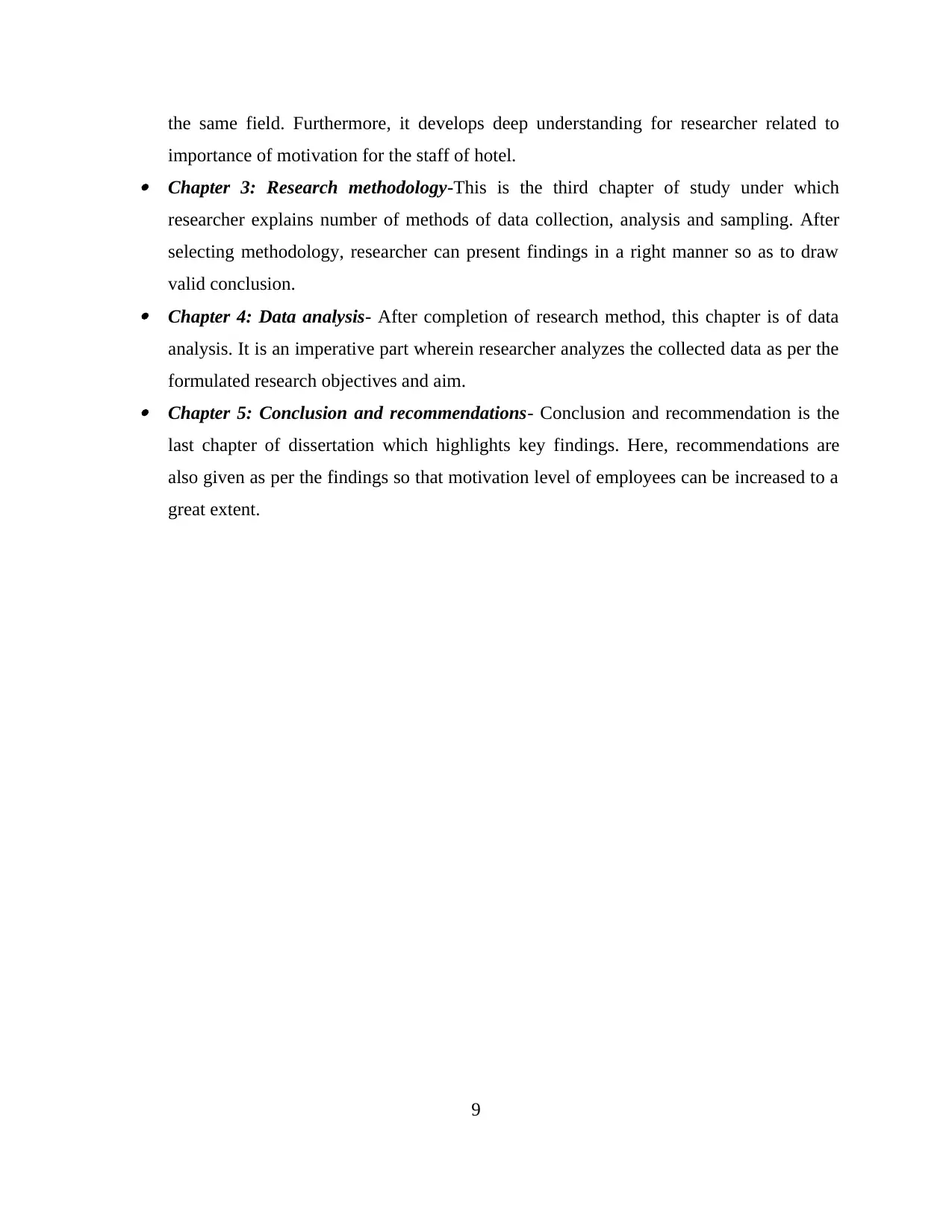
the same field. Furthermore, it develops deep understanding for researcher related to
importance of motivation for the staff of hotel. Chapter 3: Research methodology-This is the third chapter of study under which
researcher explains number of methods of data collection, analysis and sampling. After
selecting methodology, researcher can present findings in a right manner so as to draw
valid conclusion. Chapter 4: Data analysis- After completion of research method, this chapter is of data
analysis. It is an imperative part wherein researcher analyzes the collected data as per the
formulated research objectives and aim. Chapter 5: Conclusion and recommendations- Conclusion and recommendation is the
last chapter of dissertation which highlights key findings. Here, recommendations are
also given as per the findings so that motivation level of employees can be increased to a
great extent.
9
importance of motivation for the staff of hotel. Chapter 3: Research methodology-This is the third chapter of study under which
researcher explains number of methods of data collection, analysis and sampling. After
selecting methodology, researcher can present findings in a right manner so as to draw
valid conclusion. Chapter 4: Data analysis- After completion of research method, this chapter is of data
analysis. It is an imperative part wherein researcher analyzes the collected data as per the
formulated research objectives and aim. Chapter 5: Conclusion and recommendations- Conclusion and recommendation is the
last chapter of dissertation which highlights key findings. Here, recommendations are
also given as per the findings so that motivation level of employees can be increased to a
great extent.
9
⊘ This is a preview!⊘
Do you want full access?
Subscribe today to unlock all pages.

Trusted by 1+ million students worldwide
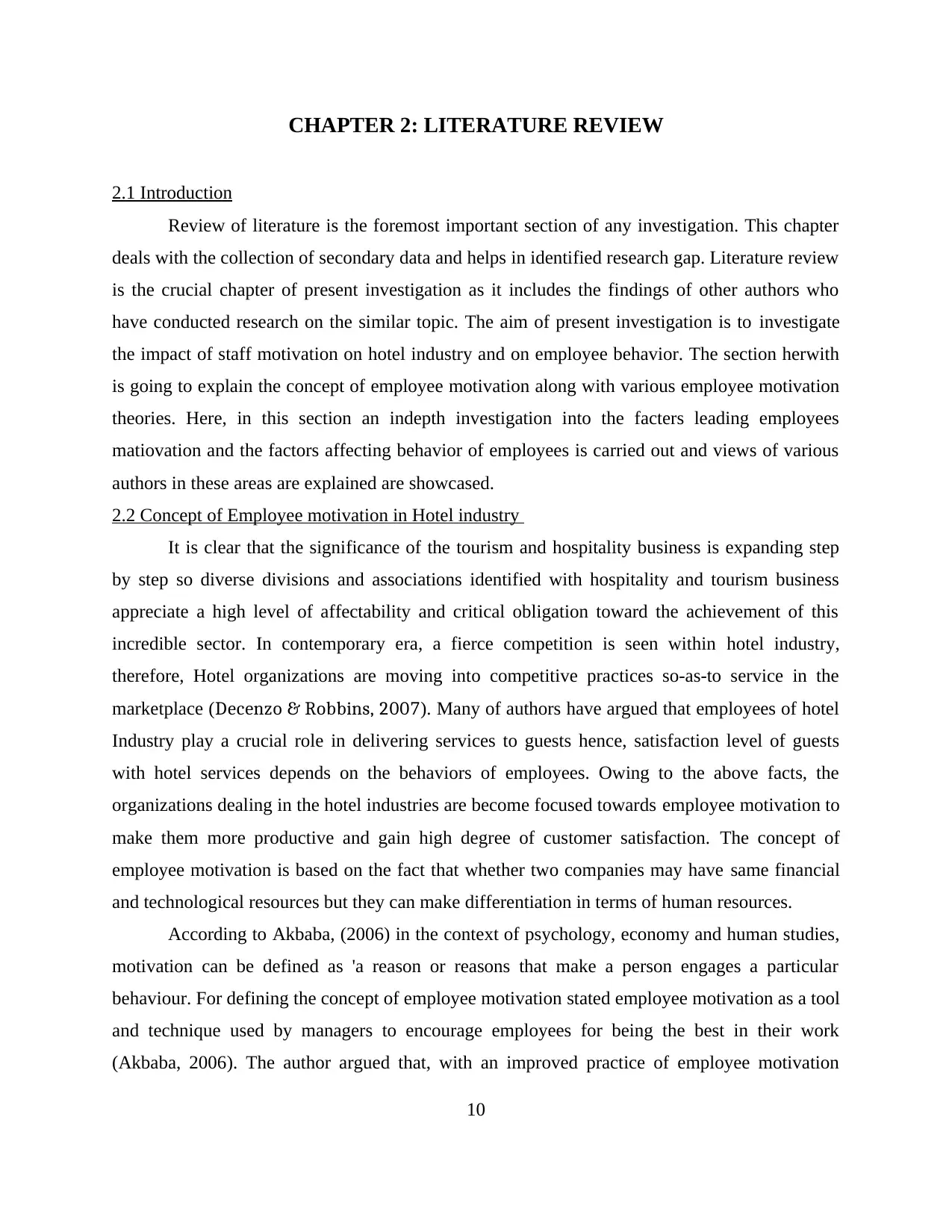
CHAPTER 2: LITERATURE REVIEW
2.1 Introduction
Review of literature is the foremost important section of any investigation. This chapter
deals with the collection of secondary data and helps in identified research gap. Literature review
is the crucial chapter of present investigation as it includes the findings of other authors who
have conducted research on the similar topic. The aim of present investigation is to investigate
the impact of staff motivation on hotel industry and on employee behavior. The section herwith
is going to explain the concept of employee motivation along with various employee motivation
theories. Here, in this section an indepth investigation into the facters leading employees
matiovation and the factors affecting behavior of employees is carried out and views of various
authors in these areas are explained are showcased.
2.2 Concept of Employee motivation in Hotel industry
It is clear that the significance of the tourism and hospitality business is expanding step
by step so diverse divisions and associations identified with hospitality and tourism business
appreciate a high level of affectability and critical obligation toward the achievement of this
incredible sector. In contemporary era, a fierce competition is seen within hotel industry,
therefore, Hotel organizations are moving into competitive practices so-as-to service in the
marketplace (Decenzo & Robbins, 2007). Many of authors have argued that employees of hotel
Industry play a crucial role in delivering services to guests hence, satisfaction level of guests
with hotel services depends on the behaviors of employees. Owing to the above facts, the
organizations dealing in the hotel industries are become focused towards employee motivation to
make them more productive and gain high degree of customer satisfaction. The concept of
employee motivation is based on the fact that whether two companies may have same financial
and technological resources but they can make differentiation in terms of human resources.
According to Akbaba, (2006) in the context of psychology, economy and human studies,
motivation can be defined as 'a reason or reasons that make a person engages a particular
behaviour. For defining the concept of employee motivation stated employee motivation as a tool
and technique used by managers to encourage employees for being the best in their work
(Akbaba, 2006). The author argued that, with an improved practice of employee motivation
10
2.1 Introduction
Review of literature is the foremost important section of any investigation. This chapter
deals with the collection of secondary data and helps in identified research gap. Literature review
is the crucial chapter of present investigation as it includes the findings of other authors who
have conducted research on the similar topic. The aim of present investigation is to investigate
the impact of staff motivation on hotel industry and on employee behavior. The section herwith
is going to explain the concept of employee motivation along with various employee motivation
theories. Here, in this section an indepth investigation into the facters leading employees
matiovation and the factors affecting behavior of employees is carried out and views of various
authors in these areas are explained are showcased.
2.2 Concept of Employee motivation in Hotel industry
It is clear that the significance of the tourism and hospitality business is expanding step
by step so diverse divisions and associations identified with hospitality and tourism business
appreciate a high level of affectability and critical obligation toward the achievement of this
incredible sector. In contemporary era, a fierce competition is seen within hotel industry,
therefore, Hotel organizations are moving into competitive practices so-as-to service in the
marketplace (Decenzo & Robbins, 2007). Many of authors have argued that employees of hotel
Industry play a crucial role in delivering services to guests hence, satisfaction level of guests
with hotel services depends on the behaviors of employees. Owing to the above facts, the
organizations dealing in the hotel industries are become focused towards employee motivation to
make them more productive and gain high degree of customer satisfaction. The concept of
employee motivation is based on the fact that whether two companies may have same financial
and technological resources but they can make differentiation in terms of human resources.
According to Akbaba, (2006) in the context of psychology, economy and human studies,
motivation can be defined as 'a reason or reasons that make a person engages a particular
behaviour. For defining the concept of employee motivation stated employee motivation as a tool
and technique used by managers to encourage employees for being the best in their work
(Akbaba, 2006). The author argued that, with an improved practice of employee motivation
10
Paraphrase This Document
Need a fresh take? Get an instant paraphrase of this document with our AI Paraphraser

workers can be motivated for preforming more effectively and efficiently. In the similar fashion,
Cadwaller and et.al. (2010) revealed that the concept of employee motivation and its application
within corporate workplaces have lead to organizations for identifying the factors encouraging
workers to give their best. However, previous authors have found employee motivation as an
aspect of gaining competitive advantages (Cadwaller and et.al. 2010). In the investigation
conducted by Halal, (2003) found that hotel industry has very high rate of employee turnover and
the practice of employee motivation may lead to lower down this rate. By it has been
investigated that employees of hotels industry are dissatisfied due to low wages and inflexible
environment (Halal, 2003). Therefore, workers in the hotel industry must be motivated through
using combined factors affecting employee motivation in a positive manner.
2.3 Theoretical framework of employee motivation
According to Varey, (2002) managers are focused towards applying various motivation
theories that are used to motivate employees in an organization. In respect with the hospitality
industry employee motivation theories are significantly used for the purpose of improving
service quality as well as to encourage people for rendering the best services to guests (Varey,
2002). The range of employee motivation theories includes Maslow's need-hierarchy theory,
Herzberg's two-factor theory, Adams' equity theory, Vroom's expectancy theory, etc. In this,
investigations different theories of motivation is applied in understanding needs and expectation
of employees. Among various theories, authors have found Maslow's need hierarchy is one of
the effective aspects under which basic needs of workforce is understood. Also, this helps
management to understand overall scenario of employees motivation and accordingly provide
them motivation.
The previous authors have revealed that Maslow's need-hierarchy theory is applied in the
hotel industry in which managers focus on satisfying the needs of employees in a hierarchical
format. To the similar aspects, studied the use of need-hierarchy theory within hotel industry and
revealed that managers can motivate employees while satisfying the needs of workers which are
divided into five major levels such as physiological, safety, social, self esteem and self-
actualizing. The use of Herzberg's theory is studied in the investigation of Hossain and Hossain
(2012) in which author has found that motivators and hygienes are two major factors that are
used to motivate people at the workplace. In this regard, intrinsic factors come in motivators i.e.
11
Cadwaller and et.al. (2010) revealed that the concept of employee motivation and its application
within corporate workplaces have lead to organizations for identifying the factors encouraging
workers to give their best. However, previous authors have found employee motivation as an
aspect of gaining competitive advantages (Cadwaller and et.al. 2010). In the investigation
conducted by Halal, (2003) found that hotel industry has very high rate of employee turnover and
the practice of employee motivation may lead to lower down this rate. By it has been
investigated that employees of hotels industry are dissatisfied due to low wages and inflexible
environment (Halal, 2003). Therefore, workers in the hotel industry must be motivated through
using combined factors affecting employee motivation in a positive manner.
2.3 Theoretical framework of employee motivation
According to Varey, (2002) managers are focused towards applying various motivation
theories that are used to motivate employees in an organization. In respect with the hospitality
industry employee motivation theories are significantly used for the purpose of improving
service quality as well as to encourage people for rendering the best services to guests (Varey,
2002). The range of employee motivation theories includes Maslow's need-hierarchy theory,
Herzberg's two-factor theory, Adams' equity theory, Vroom's expectancy theory, etc. In this,
investigations different theories of motivation is applied in understanding needs and expectation
of employees. Among various theories, authors have found Maslow's need hierarchy is one of
the effective aspects under which basic needs of workforce is understood. Also, this helps
management to understand overall scenario of employees motivation and accordingly provide
them motivation.
The previous authors have revealed that Maslow's need-hierarchy theory is applied in the
hotel industry in which managers focus on satisfying the needs of employees in a hierarchical
format. To the similar aspects, studied the use of need-hierarchy theory within hotel industry and
revealed that managers can motivate employees while satisfying the needs of workers which are
divided into five major levels such as physiological, safety, social, self esteem and self-
actualizing. The use of Herzberg's theory is studied in the investigation of Hossain and Hossain
(2012) in which author has found that motivators and hygienes are two major factors that are
used to motivate people at the workplace. In this regard, intrinsic factors come in motivators i.e.
11
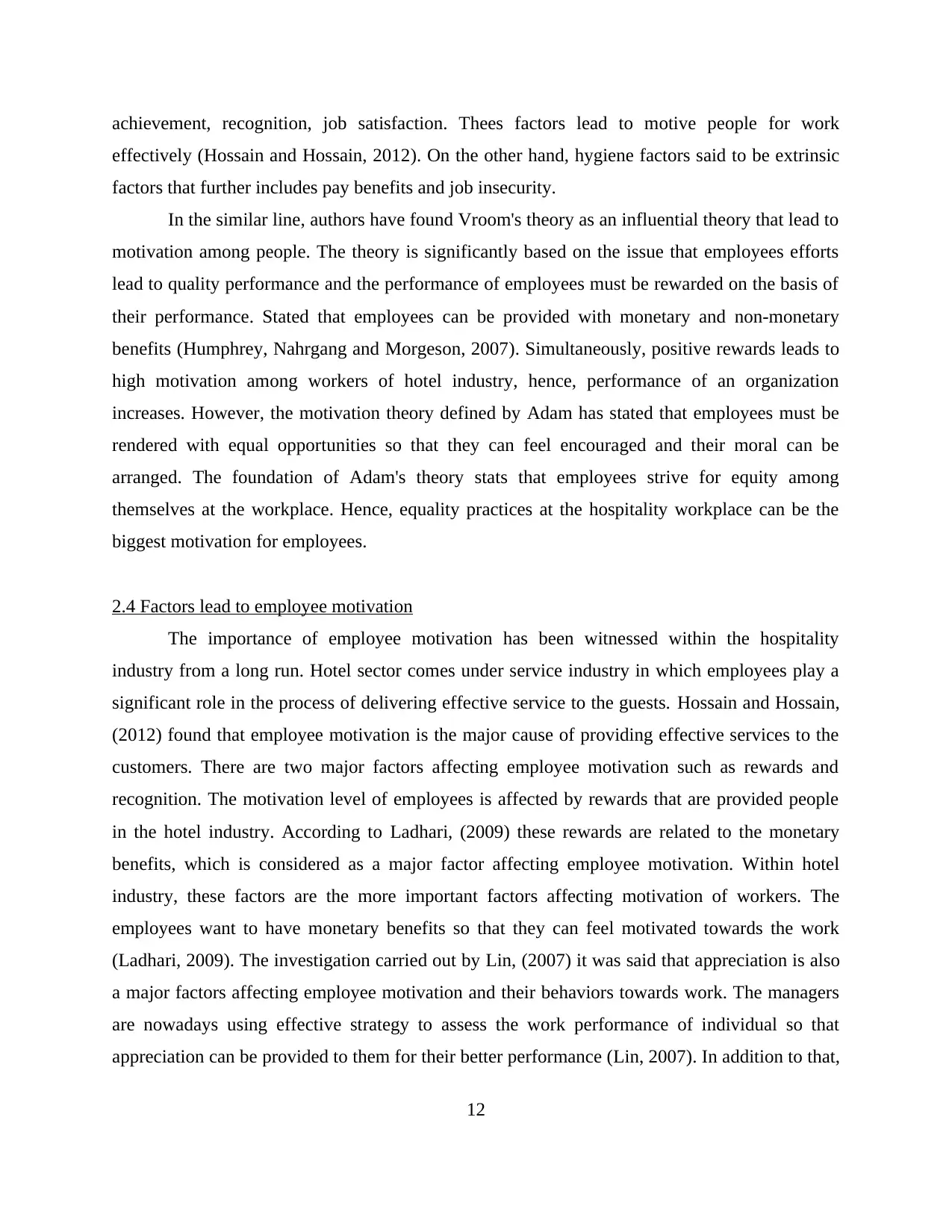
achievement, recognition, job satisfaction. Thees factors lead to motive people for work
effectively (Hossain and Hossain, 2012). On the other hand, hygiene factors said to be extrinsic
factors that further includes pay benefits and job insecurity.
In the similar line, authors have found Vroom's theory as an influential theory that lead to
motivation among people. The theory is significantly based on the issue that employees efforts
lead to quality performance and the performance of employees must be rewarded on the basis of
their performance. Stated that employees can be provided with monetary and non-monetary
benefits (Humphrey, Nahrgang and Morgeson, 2007). Simultaneously, positive rewards leads to
high motivation among workers of hotel industry, hence, performance of an organization
increases. However, the motivation theory defined by Adam has stated that employees must be
rendered with equal opportunities so that they can feel encouraged and their moral can be
arranged. The foundation of Adam's theory stats that employees strive for equity among
themselves at the workplace. Hence, equality practices at the hospitality workplace can be the
biggest motivation for employees.
2.4 Factors lead to employee motivation
The importance of employee motivation has been witnessed within the hospitality
industry from a long run. Hotel sector comes under service industry in which employees play a
significant role in the process of delivering effective service to the guests. Hossain and Hossain,
(2012) found that employee motivation is the major cause of providing effective services to the
customers. There are two major factors affecting employee motivation such as rewards and
recognition. The motivation level of employees is affected by rewards that are provided people
in the hotel industry. According to Ladhari, (2009) these rewards are related to the monetary
benefits, which is considered as a major factor affecting employee motivation. Within hotel
industry, these factors are the more important factors affecting motivation of workers. The
employees want to have monetary benefits so that they can feel motivated towards the work
(Ladhari, 2009). The investigation carried out by Lin, (2007) it was said that appreciation is also
a major factors affecting employee motivation and their behaviors towards work. The managers
are nowadays using effective strategy to assess the work performance of individual so that
appreciation can be provided to them for their better performance (Lin, 2007). In addition to that,
12
effectively (Hossain and Hossain, 2012). On the other hand, hygiene factors said to be extrinsic
factors that further includes pay benefits and job insecurity.
In the similar line, authors have found Vroom's theory as an influential theory that lead to
motivation among people. The theory is significantly based on the issue that employees efforts
lead to quality performance and the performance of employees must be rewarded on the basis of
their performance. Stated that employees can be provided with monetary and non-monetary
benefits (Humphrey, Nahrgang and Morgeson, 2007). Simultaneously, positive rewards leads to
high motivation among workers of hotel industry, hence, performance of an organization
increases. However, the motivation theory defined by Adam has stated that employees must be
rendered with equal opportunities so that they can feel encouraged and their moral can be
arranged. The foundation of Adam's theory stats that employees strive for equity among
themselves at the workplace. Hence, equality practices at the hospitality workplace can be the
biggest motivation for employees.
2.4 Factors lead to employee motivation
The importance of employee motivation has been witnessed within the hospitality
industry from a long run. Hotel sector comes under service industry in which employees play a
significant role in the process of delivering effective service to the guests. Hossain and Hossain,
(2012) found that employee motivation is the major cause of providing effective services to the
customers. There are two major factors affecting employee motivation such as rewards and
recognition. The motivation level of employees is affected by rewards that are provided people
in the hotel industry. According to Ladhari, (2009) these rewards are related to the monetary
benefits, which is considered as a major factor affecting employee motivation. Within hotel
industry, these factors are the more important factors affecting motivation of workers. The
employees want to have monetary benefits so that they can feel motivated towards the work
(Ladhari, 2009). The investigation carried out by Lin, (2007) it was said that appreciation is also
a major factors affecting employee motivation and their behaviors towards work. The managers
are nowadays using effective strategy to assess the work performance of individual so that
appreciation can be provided to them for their better performance (Lin, 2007). In addition to that,
12
⊘ This is a preview!⊘
Do you want full access?
Subscribe today to unlock all pages.

Trusted by 1+ million students worldwide
1 out of 50
Related Documents
Your All-in-One AI-Powered Toolkit for Academic Success.
+13062052269
info@desklib.com
Available 24*7 on WhatsApp / Email
![[object Object]](/_next/static/media/star-bottom.7253800d.svg)
Unlock your academic potential
Copyright © 2020–2025 A2Z Services. All Rights Reserved. Developed and managed by ZUCOL.





